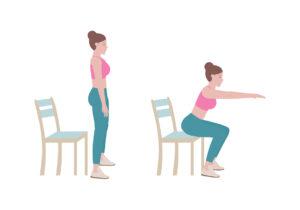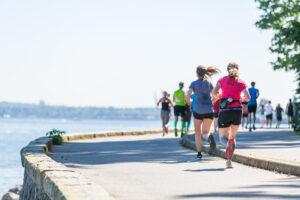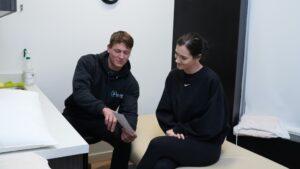
If you’ve done a workout class recently, chances are the instructor got you to do squats. And for good reason! Squats are one of the most important foundational movement patterns when it comes to strength training. By engaging such a wide range of muscles, squats prove to be an excellent exercise for overall strength and conditioning.
What muscles do squats work?
While squats primarily target lower body muscles, they also activate several muscles above the waist making this exercise a full-body movement.
Main muscles targeted while squatting:
- Quadriceps
- Hamstrings
- Gluteus maximus, minimus, and medius
- Adductor (groin)
- Hip flexors
- Calves
- Rectus abdominis,
- Obliques
- Transverse abdominis
- Erector spinae
How to perform the perfect squat
Known as a bodyweight squat or an air squat, the most basic type of squat uses just your body weight for resistance. Variations of the squat can include weights like dumbbells, yoga balls, or resistance bands.
When you begin, the pressure in the squat should be placed almost evenly through your feet. Imagine a triangle on the sole of your foot, with pressure placed equally in three areas: on the front of the foot right behind the big toe, on the front of the foot behind the pinky toe, and on the heel!
Here are the basic steps to perform a basic bodyweight squat:
- Stand with your feet slightly wider than shoulder-width apart. Keep your toes pointing forward, core engaged, and your chest open.
- Inhale, bend your knees, and push your hips backward as if you are reaching back to sit in a chair. Keep your back straight and chest up as your arms come forward in front of your body to act as a counterweight.
- Lower your body until your thighs are parallel to the floor and knees are bent at 90 degrees.
- Exhale as you press your heels into the ground and return to the starting position.

Benefits of squats
They strengthen your legs.
It is no news that squats primarily target the legs. Squats strengthen your glutes (butt muscles), which are essential for power, core stability, and efficient forward propulsion when running, walking, jumping, and skipping.
Squats also target the quads, a group of four muscles on the front of your thigh that controls knee extension. On the backside of the legs, squats work hamstrings and calves, both of which are instrumental in walking, running, and jumping.
Squats improve core strength
A 2018 study that compared core muscle activation during a plank with back squats found that back squats resulted in greater activation of the muscles that support your back.
Based on these findings, the researchers recommended targeting the core muscles with back squats to reduce the risk of injury and to boost athletic performance.
Having strong core muscles can make everyday movements like turning, bending, and even standing easier. Not only that, but a strong core can improve your balance, ease pain in your low back, and make it easier to maintain good posture.
Squats increase your vertical jump
If you play sports like volleyball, basketball, or tennis, you’ll appreciate the boost your jump gets from consistent squat workouts! The strength you’ll develop in your glutes, hamstrings, and calves from squats will help power a more explosive, impressive jumping ability!
Squats can improve bone density
It’s true! Loading your bones during squats can signal your body to increase the mineralization of your bones. This also turns on key hormones that build bone rather than break it down. Bone density is vital as we age, so it’s certainly worth focusing on squats at the gym to delay bone loss!
Squats improve your posture
This is one of our all time favorite benefits of squats — the core strengthening work along the erector spinae of the spine helps improve posture! Poor posture is the source so much neck pain, back pain, sleep disturbances, and even slower metabolism. During a squat, you must keep your back straight and chest up while carrying the heavy load, which is another factor that also encourages good posture outside of the gym!
Squats burn calories
Like any exercise, performing squats — especially weighted squats — burns calories. Even more importantly, building lean muscle mass through exercises like squats increases your overall metabolic rate.
When performed quickly or in a circuit, squats also improve cardiovascular fitness and heart health. A set of squats is sure to get your heart pumping and lungs expanding!
Squats can be done anywhere
To do bodyweight squats, you don’t need access to a gym or any equipment. All you need is your body and enough room to lower your hips into a sitting position!
If you’re pressed for time, you can still benefit many muscle groups by doing 50 squats a day. Start with doing 25 in the morning and 25 in the evening! As you get stronger, you can even add 25 to the afternoon for an extra boost.
Check your form at Synergy Rehab
Incorporating squats into your workout or daily routine offers a multitude of benefits that stretch beyond strength and power development. When executed with proper form, this functional exercise reduces the risk of injuries, enhances calorie burn, strengthens the core muscles, and contributes to improved posture and balance.
Not sure about your squat form? Recovering from an injury that’s preventing you from exercising? Schedule an appointment with a physiotherapist near you. We’ll have you back and squatting in no time! We’ve got your back.








